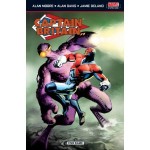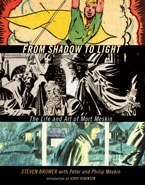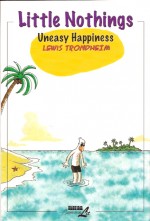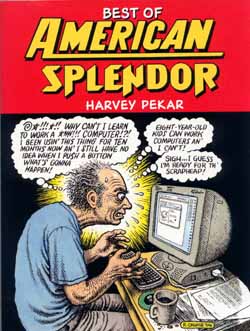
By Alan Moore, Alan Davis, Jamie Delano, Grant Morrison & others (Marvel/Panini UK)
ISBN: 978-1-84653-459-1
Marvel UK set up shop in 1972, reprinting the company’s earliest US successes in the traditional British weekly format, swiftly carving out a solid slice of the market – although the works of Lee, Kirby et al had already been appearing in other British comics (Smash!, Wham!, Pow!, Eagle, Fantastic!, Terrific!), and the anthologies of Alan Class Publications (which re-packaged a mesmerising plethora of American comics from Marvel, Charlton, Tower and ACG among others in comforting, cheap black and white) since their inception thanks to the aggressive marketing and licensing policies of and Stan and the gang.
In 1976 Marvel decided to augment their output with an original British hero in a new weekly – albeit in that parochial, US style and manner beloved by English comics readers. Although the new title still included fan favourites Fantastic Four and Agent of S.H.I.E.L.D. reprints filled out the issues, one bold departure was the addition of full colour printing up front for the new hero, and the equivalent back quarter of each issue.
Physics student Brian Braddock was in just the wrong place when raiders attacked the Atomic research centre on Darkmoor, but when he fled the brutal assault he stumbled onto a source of fantastic power and his inescapable destiny. Chosen by the legendary Merlin himself, Braddock was transformed into the symbolic champion of our Island Nation and battled incredible threats as the valiant Captain Britain…
This fifth volume chronologically completes the full-colour adventures of Marvel’s Greatest British super-hero prior to his being conscripted into the X-Men’s ponderous niche-continuity, gathered from Mighty World of Marvel #7-16 and the entire 14 issue run of Captain Britain volume 2 (January 1985-February 1986).
After a brief introductory reminiscence from multi-talented star-turn Alan Davis the action begins with ‘The Candlelight Dialogues’ by Alans Moore and Davis from Mighty World of Marvel #7 (and providing a plot-strand bled dry by Chris Claremont and successive X-Scribes over the next two decades in the US comicbooks)…
Two female internees converse in a prison camp after lights out: recounting tales of a legendary hero who will free them from bondage. The World has been taken over by fascist human forces incarcerating or destroying all the different ones… freaks, mutants, superheroes.
This tale introduces the amazing mystic metamorph Meggan who would become Captain Britain’s long-term inamorata, but the really big reveal is that our world also has a reality-warping Mad Jim Jaspers (see Captain Britain: the Siege of Camelot) – the big difference being that here he won and creation has become his instantly plastic plaything…
Issue #8 sets up a cataclysmic confrontation in ‘The Twisted World (Reprise)’ as infallible hero-killing super-weapon the Fury is still hunting, even though Jaspers has reworked the world into his own twisted version of a totalitarian paradise. Captain Britain, his sister Betsy, Omniversal fugitives Saturnyne and Captain UK, sole survivor of her murdered dimension, lead the last few rebels against the New Reality as Jaspers consolidates his psychotic hold on the nation. The fugitives’ consensus choice is “attack or dieâ€â€¦
Meanwhile in the higher realms, Merlin and his daughter move their human pieces in the great game to save our existence. In ‘Among These Dark Satanic Mills’ the good Captain struggles on but not without telling losses, confronting Jaspers as the madman begins his ascent to literal godhood in ‘Anarchy in the UK’.
Even so the cause seems hopeless until the long forgotten Fury enters the fray on nobody’s side but intent on taking out the greatest threat first in ‘Fool’s Mate’ – the beginning of an unbelievably intense and imaginative battle with Jaspers across the multi-verse using the building blocks of reality as ammunition. The chaotic clash continues in ‘Endgame’ with shocks and surprises aplenty, leading to unexpected victory, the death of a major player and in Mighty World of Marvel #13, ‘A Funeral on Otherworld’.
Moore left the strip with that wrap-up and re-set, leaving artist Davis to write (with the assistance of letterer Steve Craddock) the next episode ‘Bad Moon Rising’ which found the country recovering from the physical and psychic trauma of the Jaspers-Warp and the good Captain taking stock of the nation he represents. A less cosmic, more socially aware phase was beginning, and saw the hero meet the were-creature Meggan and make the most tragic mistake of his career.
‘Tea and Sympathy’ is a mini-masterpiece of sensitive, underplayed writing from Davis, following the hero as he meets the family of a boy who died as result of his actions and presaging the next extended epic, which begins in the Mike Collins co-scripted ‘In All the Old, Familiar Places…’
This last Mighty World of Marvel tale follows Betsy, Meggan and the surviving anti-Jaspers rebels as they take up residence at Braddock Manor, ancestral seat of Captain Britain’s family. However inimical forces are gathering to assault the weary champions and interdimensional raiders keep blipping in and out. Luckily Betsy’s psychic powers keep magnifying in strength…
The feature had been growing in popularity and was considered strong enough to carry its own title once more so in January 1985 Captain Britain volume 2 launched, with a selection of related strips and the Lion of Albion exploding into new adventures scripted by up-and-coming writer Jamie Delano.
‘Pictures, Puzzles and Pawns’ recapped the Captain’s career courtesy of Chief Inspector Dai Thomas, a cop with a grudge against metahumans, who had deduced the hero’s secret identity only to be sidelined by his own bosses. Meanwhile, not all the effects of Jasper’s reality-twisting had faded, and animated Alice in Wonderland characters the Crazy Gang were stranded on Earth with no visible means of support.
Vicious, demented and painfully simplistic, the larcenous loons went looking for a leader in ‘Law and Disorder’ finding instead Captain Britain’s most dangerous enemy whilst yet another trans-dimensional transgressor continued to make life difficult for Brian Braddock and friends…
Issue #3 saw the hero captured by Slaymaster and criminal mastermind Vixen in ‘Flotsam and Jetsam’ and heralded a new and darker hero, whilst ‘Sid’s Story’ (written by Collins and Davis) provided a moody change of pace to leaven a monster story with a mighty dose of pathos, before Delano returned for ‘Double Game’ as the multiversal mercenary squad Gatecrasher’s Technet whisked the Captain to a Britain ruled by Nazis, uncomprehendingly leaving behind his fascist doppelganger to run amok on our world…
Trapped ‘A Long Way From Home’ Brian Braddock and Technet had to fight their way back to our Earth, only to find Betsy’s terrifyingly growing psychic powers had already saved the day, whilst in ‘Things Fall Apart’ the Manor’s sentient super-computer Mastermind reactivated and revealed the true origins and heritage of the Braddock clan…
The secret of Meggan and her true nature came under scrutiny in #8’s ‘Childhood’s End’ and government intelligence unit Resources Control Executive invited themselves to stay, wanting the mansion as an orphanage for “Warpies†– super-powered children mutated by Jaspers’ reality-shifts. Naturally it all went wrong, resulting in a big battle but the ‘Winds of Change’ had unexpected repercussions and Brian and Meggan stormed off, leaving Betsy and Mastermind in the pocket of the RCX.
The Braddock twins had an older brother, and his past exploits dragged the lovers Brian and Meggan into a shocking ‘African Nightmare’ after which the disheartened couple went searching for Meggan’s Romany roots and became ensnared in the mystic horrors of ‘The House of Baba Yaga’, after which Gatecrasher’s Technet shanghaied them to the height of the Incan Empire for a nasty case of “Bait-and-Switch†in ‘Alarms and Excursions’.
Finally home the young lovers found RCX in charge and Betsy had become the new Captain Britain. Furious, Brian quit but was back in the very next issue when Betsy tragically learned the excessively hard way that ‘It’s Hard to Be A Hero…’ written, as was the concluding ‘Should Auld Acquaintance…’ by Davis, wherein the reunited but far from happy family experienced one last hurrah rescuing a Warpy from a exploitation at the hands of a Glasgow vigilante, and still finding space to wrap up all the plot threads in an expansive Happy Ever After…
But wait… there’s more…
One of the back-up strips in Captain Britain was a four-part tale starring a group of Warpy children dubbed the Cherubim, who had escaped RCX control at the end of #11’s ‘Winds of Change’. Written and drawn by Mike Collins with inks by Mark Farmer ‘Playgrounds and Parasites!’ told how the homeless wanderers encountered a Fagin-like young charmer who was gathering Jasper’s mutants into a band for their own protection – and his profit.
That complete saga is re-presented here in the original black and white after which a young Grant Morrison closes the entertainment with a prose tale of alternate champion ‘Captain Granbretan’, lavishly illustrated by John Stokes and ‘A New Vision of Captain Britain’ close the book with a selection of captivating sketches and rare or unseen artwork.
Captain Britain End Game sees the character finally reach the absolute heights of his potential and features some of the industry’s greatest talents at the top of their game. This is not only a wonderful nostalgic collection for old-timers and dedicated fans but also a book full of the best that superhero comics can offer… Some of the very best material ever produced by Marvel, this is a book every reader would be happy to have.
© 1983, 1984, 1985, 1986, 2011 Marvel Entertainment, Inc. and its subsidiaries, licensed by Marvel Characters, Inc. All Rights Reserved. (A British edition from PANINI UK LTD)






 Â
Â